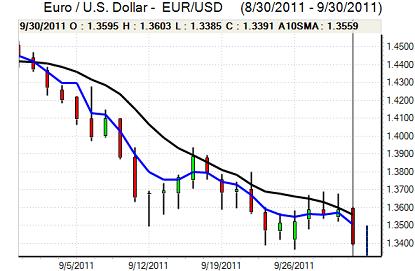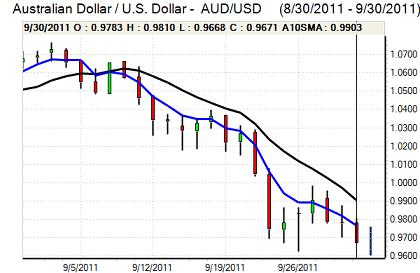EUR/USD
The Euro was unable to move above 1.36 against the dollar during Friday and came under sustained pressure as underlying sentiment remained weak. There was further evidence of quarter-end demand for the US currency which provided solid underlying support while underlying Euro confidence remained very weak.
There were further concerns that the stronger powers for the EFSF would not be sufficient to contain the Euro-zone debt crisis, especially with Germany ruling out any further increase in the fund. There were also still some concerns that Slovakia could continued to block the fund changes with a vote tentatively scheduled for this week.
The latest German retail sales data was sharply weaker than expected with a 2.9% August decline following a revised 0.3% increase the previous month. Although there had been a very strong figure for June, the weak data increased fears over a very sharp slowdown within the Euro area.
The September flash inflation rate rose sharply to 3.0% from 2.5% previously and this data will make it much more difficult for the ECB to justify a cut in interest rates on inflation grounds. In this context, there may be some decline in speculation over a 0.50% cut in rates.
The US personal income and core PCE deflator were slightly weaker than expected, although the market impact was limited. There was a small increase in the revised University of Michigan consumer confidence index for September while there was also a stronger than expected Chicago PMI reading at 60.4 from 56.5 previously.
Confidence in the Euro-zone banking sector continued to weaken with reports that Belgian Bank Dexia would require additional state support on bad-debt write-downs and a lack of funding facilities.
The Euro gapped lower at the start of Asian trading on Monday with sentiment further undermined by rumours that Germany could leave the Euro area. It was also announced that Greece would miss part of its latest budget deficit targets and there was further speculation that bigger haircuts would be required as default moved closer with the Euro weakening to eight-month lows near 1.3310.

Source: VantagePoint Intermarket Analysis Software
Call now and you will be provided with FREE recent forecasts
that are up to 86% accurate* 800-732-5407
If you would rather have the recent forecasts sent to you, please go here
Yen
The dollar probed resistance levels above 77 against the Japanese currency on Friday with some hedge-fund dollar demand as quarter-end yen buying faded.
The Japanese PMI index was broadly static at 51.2 for September while the Tankan quarterly manufacturing index broadly met expectations with a rise to 2 in the latest quarter from -9 previously.
Regionally, there was some relief that the latest official PMI index held comfortably above the 50 level, but there was still underlying defensive yen support.
There was further speculation that the Japanese authorities would consider intervention to reverse any yen appreciation, especially with regional Asian currencies generally weaker against the US currency which will intensify competitiveness fears within Japan.
Sterling
Sterling was unable to make much headway against the dollar during much of Friday, but there was solid support on dips to below the 1.5550 level and it briefly pushed to highs near 1.5650 late in the US session. There was a significant impact from trends in the crosses with the Euro retreating sharply to two-month lows below 0.86 against the UK currency.
Although there were still very important fears surrounding the UK economic outlook, there was also a perception that the UK would be in a better position than the Euro-zone to secure global funding, especially after the Swiss National Bank move last week to increase Sterling reserves.
There was still caution surrounding the Bank of England meeting this week, especially given speculation that there could be a move to expand quantitative easing and wider dollar gains pushed the UK currency to test support near 1.55 on Monday.
Swiss franc
The dollar found support below 0.90 against the franc during Friday and rallied firmly to a peak just above 0.91 in Asia on Monday. There was some drag on the dollar from a firmer franc against the Euro as the Euro retreated to test support below 1.2150 for the first time in two weeks. There was some disappointment that there had been no move to weaken the franc further and the Finance Minister stated that the peg was at the correct level for now.
The Swiss KOF index fell sharply to 1.21 for September from 1.61 previously, maintaining the run of disappointing data and this will also increase pressure for the National Bank to curb franc appreciation.

Source: VantagePoint Intermarket Analysis Software
Call now and you will be provided with FREE recent forecasts
that are up to 86% accurate* 800-732-5407
If you would rather have the recent forecasts sent to you, please go here
Australian dollar
The Australian dollar was blocked close to 0.98 against the US currency on Friday and weakened steadily during the day as sentiment remained on the defensive.
There was some relief over the latest PMI data from China. In contrast, there was no improvement in the domestic manufacturing PMI index which dipped to 42.3 from 43.3 previously while there was a fresh deterioration in regional confidence as fears over a sharp Asian slowdown increased.
In this environment, there was fresh selling pressure at the Asian open on Monday as the currency retreated back to below the 0.97 level with lows near 0.9610.



